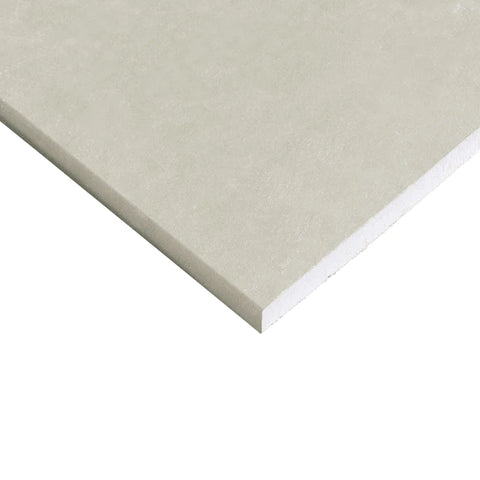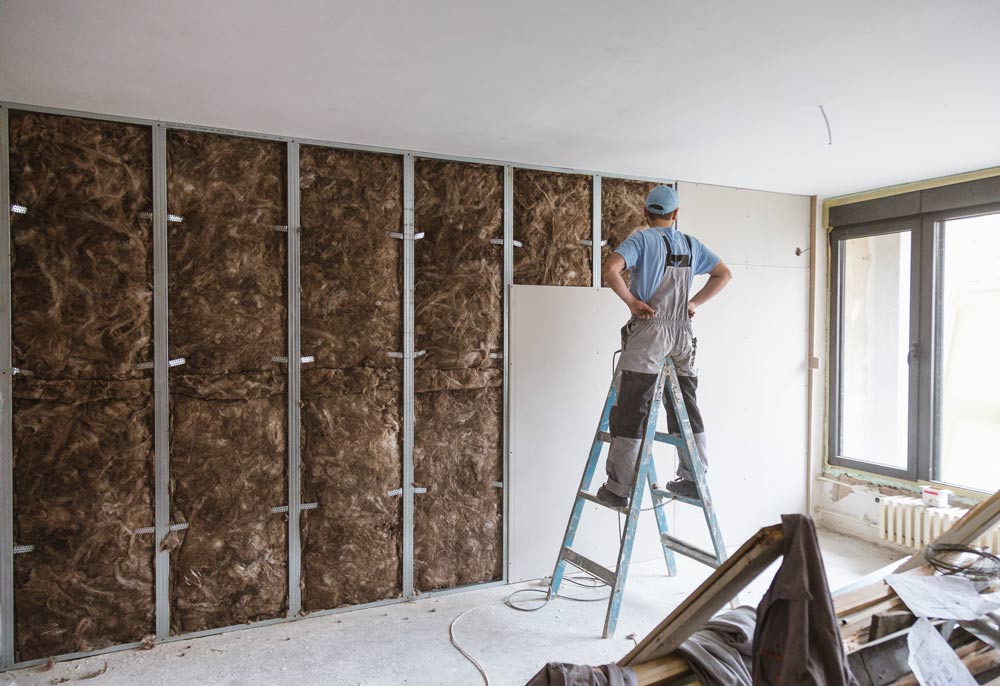Plasterboard thickness: Plasterboard comes in a range of standard sizes. It will be stacked flat on pallets in 2400 x 1200mm (8 x 4-foot) sheets and sometimes half that size at the DIY store for easy transport.
For most applications, 12.5mm plasterboard is the standard thickness, whether plastering or drylining. 9.5mm is sometimes specified for ceilings as it is lighter to handle. Some fire protection and acoustic boards are thicker at 15mm.
Here’s our guide to what thickness plasterboard is right for your project.
You Can Order Everything You Need For Plastering In Our Online Store
Standard Performance
Plasterboard is perfect for lining partition walls ready to take plaster or a tape and jointed finish. Most of the time a standard plasterboard thickness of 12.5mm will be the ideal board thickness for the job.
Size Matters
Plasterboard is available in several thicknesses, so where are they meant to be used?
Where Can I Use 12.5mm Plasterboard?
12.5mm plasterboard is the everyday standard plasterboard thickness used for almost every situation. Use this plasterboard thickness for internal walls, lining external blockwork walls or covering ceilings.

Where Can I Use 9.5mm Plasterboard?
9.5mm plasterboard is ideal for ceilings as it is lighter and easier to handle. Use it in single-storey extensions or buildings with just two floors. Always check with the local building control office as you may require a higher thickness in specific situations.
Where can I Use 15mm and 19mm Plasterboard?
15mm and 19mm are the thicknesses given to fire retardant or acoustic plasterboard. They are supplied in smaller board sizes such as 900 x 2400mm, or 600 x 2400mm, for easier handling. These boards are often specified for party walls in timber frames to manage the risks of fire and sound transmission.
Thicker plasterboard sizes are sometimes referred to as plank. It will come in smaller sizes, at 600 x 2400mm. It is designed to be a dense barrier to sound and fire and can weigh up to 15kg. Plank is fitted horizontally across party walls with another layer of plasterboard fixed over the top to take final finishes.
Moisture Resistant Plasterboard
Use this in bathrooms, en-suites kitchens, or other areas where a tile finish is specified. They weigh slightly heavier than plasterboard sheets of the same size. These boards are not waterproof and should be tanked in wet areas.
Top Tip:
9.5mm plasterboard bends well if you are boarding a curved wall. However, beware of this if you are storing any plasterboard by leaning it up against a wall. If it gets damp and distorts, it will be under stress when fixing it flat and may crack. Always store plasterboard flat whenever possible.
Square or Tapered Edge?
Square edge plasterboard is for use with traditional plaster finishes while tapered edge is designed for tape and jointing. Plaster uses more water and takes longer to cure for decorating than tape and jointing but does deliver a fine finish.
Tape and jointing is a faster way to finish internal walls, however, sanding the joints can be a dusty job if you are not using a sander with an extract system.
Either way, a neat and tidy plasterboard job means the follow-on trades and your client, will both feel the benefit.

Manual Handling
A forklift will only get you so far with plasterboard sheets. They are big, heavy, and unwieldy, and there’s a good chance that it will come down to something other than horsepower to get the plasterboard where it needs to be.
Plasterboard sheets come in pairs, taped together on the short edge, and weigh in at 46kg the pair (or 23kg per sheet). It is possible to peel off the tape, separate the boards and lift them individually into place, but they are big and can be awkward for one person to lift.
The best, controlled way to get the boards to where you need them is to have help. Two people working together, one at each end, will have better control over the boards, even in windy conditions.
Top Tip:
When you need to get plasterboard upstairs, or into a difficult-to-reach location, perhaps your project is a loft conversion with difficult access, consider cutting the plasterboard to size before attempting to move it. Standard stud distances will make this an easy way to do a difficult task.
Fire Protection
A 12.5mm sheet of plasterboard will deliver a maximum of thirty minutes of fire protection to the structure. The paper facing will scorch but the gypsum interior should resist a fire event for half an hour in a wall up to 2.5m in height.
In a partition wall with a 12.5mm sheet of plasterboard on each side, the fire rating will still be a half hour. To increase the protection, you will need to increase the thickness of the plasterboard on both sides of the wall.
This can be achieved by doubling up, adding a second layer of plasterboard with staggered joints, or using a specialist fire-retardant board. A wall that has penetrations for switches or electrical sockets may be vulnerable unless fire-retardant electrical accessories are installed.
Top Tip:
If you need a thirty-minute fire rating on a wall over 2.5m, most specifiers recommend installing a minimum double layer of 12.5mm plasterboard, with staggered joints to achieve this.
Sound Insulation
Building Regulations in the UK demand different things. In England and Wales, the decibel level to protect against is 45dB, while it is 56dB in Scotland. Fifty decibels are set as the point when human speech becomes indistinct, so it’s referred to as the onset of privacy.
Plasterboard on its own won’t achieve this so you will likely need to use a soundproofing insulation such as Rockwool RWA45 in an internal partition wall. One pack covers 6.4m or just over 2.5 sheets of standard-size plasterboard.
If you need enhanced soundproofing, plasterboard products are designed to deaden noise and block transmission. These boards are usually thicker, at 15mm and are often specified as part of a designed noise-dampening assembly.
Top Tip:
Sound travels through the studs or other solid connections in a wall. If the wall thickness is 75mm, using 50mm or 75mm insulation will work better than forcing 100mm insulation into the space. Compressing insulation will reduce its effectiveness.

Plasterboard Fixings
Fix the plasterboard around the entire perimeter of a board or cut section at 100mm centres. Fix the boards through the entire stud length at 100mm centres too. This gives the boards the rigidity required.
In a timber stud wall, there will normally be a row of noggins at 1200mm. Fix the plasterboard to these too. All these fixings add lateral rigidity to a partition wall. Use 35mm drywall screws that have a corrosion-resistant coating.
When double-layering plasterboard that is 12.5mm thick, upgrade to 45mm drywall screws.
Can I Use Wood Screws?
Do not use wood screws or other standard fixings as they may cause staining later on if there is moisture present in the building.
Wood screws also have a coarser thread and a different head that is more likely to countersink into the plasterboard than pinch it tight to the stud, rafter, or other framework. If you run out of plasterboard screws, stop, and restock.
Top Tip:
When installing a partition wall that will have kitchen units or other cabinetry fitted to it use 12.5mm plywood or OSB as pattress supports between studs. This will add fixing positions, strength, and rigidity to a wall.
Let Us Help
At Wade, we stand ready to help with any technical advice required when you place an order. Contact us by phone, or online via email today.










































